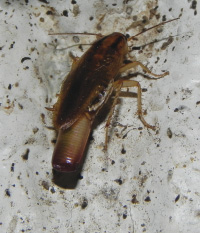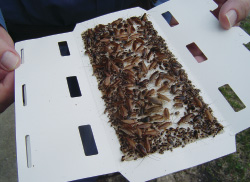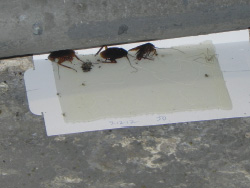This primer on cockroach biology and behavior arms pest management professionals (PMPs) to combat this perpetual public health pest.
“Cockroach Combat Manual II” Excerpt By Dr. Austin M. Frishman & Paul J. Bello
Cockroach populations, particularly of the commonly encountered German species (Blatella germanica), can mushroom overnight. Three main factors determine the carrying capacity (the maximum sustainable population) of a German cockroach population: food, shelter and water.
Shelter has the greatest impact. When pest management professionals (PMPs) reduce shelter options, they reduce populations’ carrying capacities. Sealing cracks and crevices is one effective tactic. Using plastic bags to seal cardboard boxes also significantly decreases German cockroach populations. Reducing clutter and debris is helpful, too.
If a resident leaves out unlimited cockroach food (i.e. dog food, dog feces, spilled food), hoards newspapers and boxes, has dripping faucets, and leaves out water dishes for pets, the number of cockroaches in an apartment can skyrocket quickly — possibly to more than 500,000 cockroaches. Once that carrying capacity is reached and someone mandates an intense cleanup, cockroaches typically will scatter in herds, seeking to relocate in adjacent apartments and outside.
With the exception of Oriental cockroaches (Blatta orientalis), sticky traps often work best to capture these creatures. But don’t count on these traps to eliminate most established populations.
Sticky traps also can provide valuable information:
- Proactive monitoring — As soon as cockroaches appear in traps, PMPs can deploy control measures to nip the problem in the bud.
- Harborage insight — Sticky traps can help pinpoint where cockroaches harbor.
- Control confirmation — The devices can help verify which zones are pest-free and for how long.
Also, behavioral bait resistance in some cockroach populations can become added incentive to keep sticky traps in place at all accounts.
Public health threat
Cockroaches can trigger asthma. The longer residents live with these pests, the greater the probability they will suffer asthma attacks.
Speaking to a judge in Brooklyn, N.Y., in the late 1990s, Dr. Austin Frishman was surprised to learn the No. 1 reason young children missed school was because of asthmatic attacks.
How can cockroaches be blamed for this? During the molting process, small pieces of the cast skin are produced. These tiny pieces are small and light enough to become airborne. Asthmatic reactions can be triggered in susceptible children and others who inhale the cast skin. Cockroach feces and salivary secretions are problematic, too.
Dr. Frishman recalls being invited to speak at the Albert Einstein College of Medicine in the Bronx borough of New York in 1998. All of the other speakers were medical doctors. His role was to inform the doctors about what to communicate to parents of children with this growing cockroach-related asthma problem. Most significantly, the medical doctors admitted they couldn’t solve the asthma problem with medication. It was an environmental situation that could be corrected only by eliminating the source of the allergens, which was the cockroaches. At the end of his presentation, Dr. Frishman was mobbed by doctors with additional questions.
Also during the 1990s, Paul Bello — who was based in metropolitan Atlanta working as a technical representative for Zeneca Professional Products — recalls a story that ran on the front page in the local newspaper about an infant girl who choked to death after the inadvertent aspiration of a live German cockroach.
The myriad threats cockroaches pose to public health, combined with their proven longevity and uncanny ability to proliferate, is why these pests rank Public Enemy No. 1 most years.
American cockroaches: Alarming size & speed
While German cockroaches are likely the most troublesome species that infests accounts, the American cockroach (Periplaneta Americana) also is of considerable concern to customers and PMPs. Obviously, the large size and speed of the American cockroach can be disconcerting to consumers. Over time, these large roaches can build substantial populations and, despite sharing certain characteristics with their much smaller German cousins, the American cockroach presents additional challenges that can frustrate PMPs.
Controlling American cockroaches can be significantly different than German ones. American cockroaches are much larger, faster and easier to see. Their size and speed can be alarming. Why are size and speed a consideration? Most pesticides produce mortality based on dose delivered. With American cockroaches, more insecticide often is required to control them compared to German cockroaches. The same often holds true for the use of baits and residual insecticides.
American cockroaches have the ability to elude PMPs as they inspect for the pests’ presence. Additionally, while it’s possible to use a vacuum to remove a large number of German cockroaches, American cockroaches can be too quick.
Thankfully, American cockroaches take longer to develop and build large populations compared to German ones. However, there can be a surprising number of American cockroaches present in account locations where infestations are well established. Additionally, while it’s unusual to see a significant number of German cockroaches thriving outdoors, their American counterparts can thrive outdoors and in sewage and waste pipes.
While these two species have commonalities, the way females care for their developing offspring is considerably different. A German cockroach carries her egg case during development; a female American cockroach leaves her egg case behind. Both approaches offer advantages to species survival. Egg cases carried by the female are protected from various hazards, including environmental factors, predators and pesticide residues. While egg capsules deposited and left by females might seem subject to various maladies, American cockroach egg cases often are camouflaged by females when placed, and can be located away from aggregation areas that protect them from control methodologies intended to destroy them. Such egg cases can give rise to additional cockroaches, making an American cockroach infestation much more difficult to eliminate.
No matter which cockroach species infests an account, chances are the customer will be disgusted and at a certain health risk, thanks to these creatures’ biology and behavioral habits. Cockroaches have been implicated in and associated with the transmission of numerous human pathogens and have been suspected as responsible for outbreaks of food poisoning. They’re a serious threat to the health and well-being of customers and require the industry’s best efforts. Fortunately, once we learn cockroaches’ strengths and behavior patterns, we can develop strategies and tactics to win the war.
German cockroaches’ strengths
- Cryptobiotic. Like other insect pests, they’re cryptobiotic creatures carrying on much of their daily lives in a hidden world. They spend as much as 75 percent of their time in harborages — tiny cracks, crevices and hidden voids.
- Nocturnal. They prefer darkness and are most active at night when we’re not.
- Domestic. They thrive best in close proximity to humans within structures. They take advantage of the various food, water and harborage opportunities mankind often offers them.
- Small. Their small size and flattened bodies enable them to hide in a mind-boggling number of locations including, for example, in the insulating liner of a refrigerator door.
- Fast. They run fast enough to avoid being caught and often elude detection. By the time your shoe hits the floor, they’re often gone. Contrary to popular belief, pointed shoes don’t help.
- Omnivorous. They can feed on many types of food, yet they need a balanced diet to thrive.
- Opportunistic and adaptable. They can live in all types of gadgets including smoke detectors and electronics.
- Prolific reproduction. A female German cockroach can pop out about 40 offspring a month. Even if a pest management professional (PMP) kills 90% of the German cockroaches every month, that still won’t put a dent in the total number present the next month.
- Young protection. Because adult females protect their eggs in water-resistant capsules they carry them until they’re ready to hatch, predators and parasites have little chance to reach the next generation of German cockroaches. Most other species of cockroaches deposit their egg capsules and leave them vulnerable to attack.
- Genetically resilient to inbreeding. Even in laboratory settings, generation after generation of German cockroaches — starting from a single female — can be kept alive. This is another reason one is too many.
- Armed with a host of defense mechanisms. They have early warning detectors that enable them to respond to threats and dangers quickly and escape. They have long antennae and sensory hairs and cerci on their posteriors to keep them aware of their surroundings at all times.
- Extreme temperature tolerance. German cockroaches can survive at just above freezing to almost 100° F. They thrive at typical room temperatures.
- Dense population tolerance. Whereas most animals will decline if you cram too many individuals in one small area, German cockroaches thrive in such conditions and can be seen crawling over each other without pause and constantly reproducing in the process.
German cockroaches have basic biological needs. Combine knowledge of these needs and their usual behavior and one can unlock key clues to effective control measures:
- Their fecal matter contains aggregation pheromones that attract cockroaches and cause them to harbor. Look for fecal focal points where cockroaches accumulate.
- They follow along edges and other structural cues. You’ll find them often along moldings, columns, shelves and other edges.
- They aren’t a kitchen-only pest. Any warm, moist areas attract and hold their interest. Inspect all rooms.
- Sanitation and clutter can contribute to a welcoming environment. Areas near open pet food containers and trash attract and harbor cockroaches.
- Cast or shed skins, fecal droppings and salivary material can trigger asthmatic attacks in humans. Sticky traps can help detect the cockroaches’ presence and harborage areas, and help PMPs’ protect public health.
- Egg capsules are attached to, and carried by, females until the eggs are ready to hatch. The cockroaches reproduce quickly, making early detection and complete elimination essential.
- It’s likely each customer and prospect has had them, have them now and/or will get them. Keep an eye out for them.



Leave A Comment